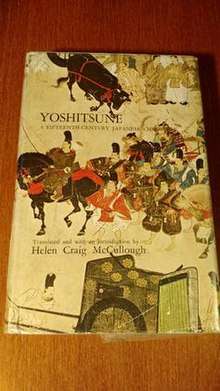Gikeiki
The Gikeiki (義経記), "The Chronicle of Yoshitsune", is a Japanese gunki monogatari ("war-tale") that focuses on the legends of Minamoto no Yoshitsune and his followers.[1] Thought to have been written during the Nanboku-chō period, it has provided inspiration to numerous Noh, kabuki and bunraku plays. Much of the image that people today have of Yoshitsune and those associated with him (Saitō no Musashibō Benkei and Shizuka Gozen, for example) is considered to have been influenced by the Gikeiki.
The word "Gikeiki" literally means "The Record of Yoshitsune", but the on-yomi of the kanji for his name are used in reading it aloud – "yoshi" (義) is read as "gi", and "tsune" (経) is read "kei". The final part "ki" means record.
All previous texts of Gikeiki are essentially the same, there are no major variations. These fall into three categories:
- Manuscripts - These include texts with titles such as Hogan Monogatari and Yoshitsune Monogatari.
- Woodblock editions - The major woodblock printings were made in 1633, 1635, 1640, 1645, 1659, 1670, 1673, 1689, 1698, 1708, and 1724.
- Movable wooden print editions - There are four movable print editions ranging from 1600 to 1633.
Translations
- McCullough, Helen Craig (1966). Yoshitsune: a fifteenth-century Japanese chronicle. Stanford, Calif.: Stanford University Press. ISBN 0804702705.
 From his fathers defeat in 1159, to his final demise in Hiraizumi in 1189.
From his fathers defeat in 1159, to his final demise in Hiraizumi in 1189. - Strugat︠s︡kogo, Arkadii︠a︡ (2000). Skazanie o Esit︠s︡unė. Sankt-Peterburg: Evrazii︠a︡. ISBN 5807100565.
See also
- Heike Monogatari
References
- Morris, Ivan (1975). The Nobility of Failure. Holt, Rinehart and Winston. pp. 93–100. ISBN 9780030108112.
External links
- Gikeiki (Japanese)